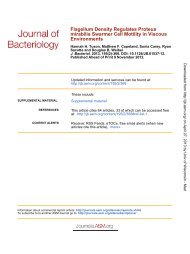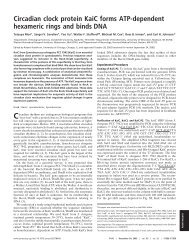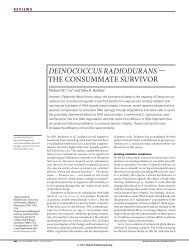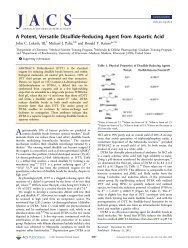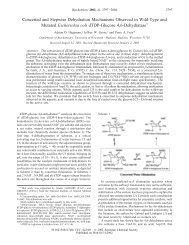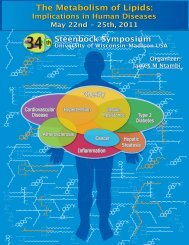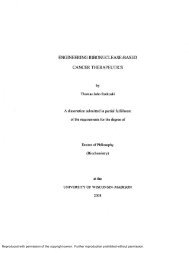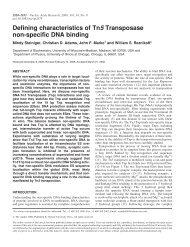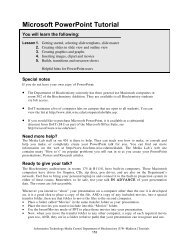The C. elegans Hand gene controls embryogenesis and early ...
The C. elegans Hand gene controls embryogenesis and early ...
The C. elegans Hand gene controls embryogenesis and early ...
Create successful ePaper yourself
Turn your PDF publications into a flip-book with our unique Google optimized e-Paper software.
2888<br />
L. D. Mathies, S. T. Henderson <strong>and</strong> J. Kimble<br />
Fig. 7. Cell death in hnd-1 mutants. Gonadal primordia: black arrow,<br />
SGP with name of cell; asterisk, PGC. (A,B) ced-2 mutants have no<br />
corpses near gonad. Z1 is in the right plane (A) <strong>and</strong> Z4 is in the left<br />
plane (B). (C,D) ced-2; hnd-1 double mutant. Z1 is missing, but a<br />
cell corpse occurs in its place at the anterior pole of the gonadal<br />
primordium (C, open arrow). Z4 is present (D). Scale bar: 5 μm.<br />
et al., 2000; Ellis et al., 1991). <strong>The</strong> engulfment of cell corpses<br />
relies on several <strong>gene</strong>s, including ced-2 (Ellis et al., 1991). In<br />
ced-2 single mutants, no cell corpses were evident near the<br />
gonad (Fig. 7A,B; n=54); however, in ced-2; hnd-1 double<br />
mutants, cell corpses were found near the gonad (Fig. 7C,D;<br />
28%, n=50). Importantly, the presence <strong>and</strong> site of corpses<br />
correlated with SGP absence. We observed no cell corpses near<br />
gonads with two SGPs (n=53), mostly anterior or right cell<br />
corpses near gonads missing Z1 (4/5; Fig. 7C), <strong>and</strong> only<br />
posterior or left cell corpses in those missing Z4 (8/8). Indeed,<br />
in one cell corpse, hnd-1::GFP was faintly expressed,<br />
indicating that it had been specified originally as an SGP (data<br />
not shown). <strong>The</strong>refore, SGPs appear to die in hnd-1 mutants.<br />
hnd-1 activity acts in somatic tissues to control<br />
gonado<strong>gene</strong>sis<br />
Both SGPs <strong>and</strong> PGCs are affected in hnd-1 mutants. To learn<br />
where hnd-1 functions, we used a combination of mosaic<br />
analysis <strong>and</strong> transgenic experiments driving the hnd-1 coding<br />
region with tissue-specific promoters.<br />
In C. <strong>elegans</strong>, mosaic animals can be made by loss of extrachromosomal<br />
arrays that carry trans<strong>gene</strong>s <strong>and</strong> that are<br />
transmitted with varying fidelity at each cell division (Herman,<br />
1984). For this study, we created an extra-chromosomal array<br />
that carries a rescuing hnd-1 genomic fragment <strong>and</strong> two<br />
fluorescent markers (myo-3::YFP to mark body muscle <strong>and</strong><br />
pes-1::CFP to mark SGPs). We then identified ‘germline<br />
mosaics’, animals that retained the array in somatic tissues but<br />
failed to transmit it to their progeny; such animals have lost the<br />
array in divisions <strong>gene</strong>rating the germline blastomere P4 (see<br />
Fig. 6). All six germline mosaics had a wild-type gonadal<br />
primordium, which suggests that hnd-1 activity acts in somatic<br />
tissues rather than in the germ line.<br />
To further explore where hnd-1 acts, we used either of two<br />
promoters: hlh-1, which is expressed in body muscle <strong>and</strong> not<br />
in SGPs (Krause et al., 1990); or lag-2, which is first expressed<br />
in the AB <strong>and</strong> MS lineages (Moskowitz <strong>and</strong> Rothman, 1996),<br />
<strong>and</strong> then in SGPs (Miskowski et al., 2001). Each promoter was<br />
fused to a full-length, rescuing hnd-1::GFP cDNA <strong>and</strong><br />
expressed in hnd-1 mutants. Expression of HND-1::GFP by the<br />
hlh-1 promoter rescued the hnd-1 gonado<strong>gene</strong>sis defects, from<br />
52% to 5% defective (n=42). By contrast, HND-1::GFP driven<br />
from the lag-2 promoter, which is expressed in the two SGPs<br />
(Fig. 5G), did not appreciably rescue hnd-1 gonado<strong>gene</strong>sis<br />
defects (36% defective, n=108). <strong>The</strong> latter experiment has the<br />
caveat that this promoter is switched on after SGPs assemble<br />
into the gonadal primordium <strong>and</strong> it may not be expressed in<br />
dying SGPs. From the hlh-1::hnd-1GFP result, we suggest that<br />
HND-1 acts in <strong>early</strong> mesodermal lineages.<br />
hnd-1 acts independently of other <strong>early</strong><br />
gonado<strong>gene</strong>sis <strong>gene</strong>s<br />
<strong>The</strong> hnd-1 SGP defects are the earliest observed to date among<br />
any <strong>gene</strong>s controlling C. <strong>elegans</strong> gonado<strong>gene</strong>sis. To investigate<br />
whether hnd-1 might function with other <strong>early</strong> gonado<strong>gene</strong>sis<br />
<strong>gene</strong>s, we explored <strong>gene</strong>tic interactions between hnd-1 <strong>and</strong> two<br />
mutant classes. <strong>The</strong> first type, represented by gon-2 <strong>and</strong> gon-4<br />
(Friedman et al., 2000; Sun <strong>and</strong> Lambie, 1997), <strong>controls</strong> the<br />
onset of cell divisions in the gonad but not in other tissues<br />
(Fig. 1C). Gonadal divisions are delayed in gon-2 or gon-4<br />
single mutants (Friedman et al., 2000; Sun <strong>and</strong> Lambie, 1997),<br />
but not in hnd-1 mutants (n=5). Moreover, hnd-1; gon-2 <strong>and</strong><br />
hnd-1; gon-4 double mutants have additive phenotypes<br />
(Materials <strong>and</strong> Methods). <strong>The</strong>refore, hnd-1 does not affect the<br />
onset or timing of gonadal divisions <strong>and</strong> acts independently of<br />
gon-2 <strong>and</strong> gon-4.<br />
<strong>The</strong> second class of <strong>early</strong> gonado<strong>gene</strong>sis <strong>gene</strong>s, represented<br />
by sys-1 (Miskowski et al., 2001), is required for SGPs to<br />
produce daughter cells with different developmental potential<br />
(Fig. 1C). In wild type, each SGP <strong>gene</strong>rates one distal tip cell<br />
(DTC), whereas in sys-1 mutants they make no DTCs<br />
(Miskowski et al., 2001). Most hnd-1 SGPs that were properly<br />
positioned <strong>gene</strong>rated DTCs (96%, n=193; Table 3), <strong>and</strong> no<br />
<strong>gene</strong>tic interactions were found with sys-1 (Materials <strong>and</strong><br />
Methods). <strong>The</strong>refore, hnd-1 does not appear to affect SGP<br />
asymmetric divisions, but instead ensures that two SGPs are<br />
present <strong>and</strong> properly positioned in the gonadal primordium.<br />
Identification of <strong>gene</strong>tic enhancers of hnd-1<br />
To identify additional <strong>gene</strong>s controlling SGP development,<br />
we screened for EMS-induced mutants with a hnd-1-like<br />
gonado<strong>gene</strong>sis phenotype <strong>and</strong> discovered loss-of-function<br />
mutations of ehn-1 <strong>and</strong> ehn-3 [for enhancer of <strong>H<strong>and</strong></strong> (Materials<br />
<strong>and</strong> Methods)]. <strong>The</strong> ehn-1 <strong>and</strong> ehn-3 mutants had lowpenetrance<br />
gonadal defects (Table 1). For ehn-1, gonadal<br />
defects could be rescued either maternally or zygotically, but<br />
ehn-3 exhibited no maternal effect (Materials <strong>and</strong> Methods).<br />
Furthermore, ehn-1 had low-penetrance lethality, but lethality<br />
was negligible in ehn-3 mutants (Table 4).<br />
<strong>The</strong> gonadal primordia of ehn-1 <strong>and</strong> ehn-3 mutants had<br />
absent or misplaced SGPs, as described above for hnd-1<br />
mutants (Table 2A,B). However, hnd-1, ehn-1 <strong>and</strong> ehn-3<br />
displayed subtle differences in their spectrum of defects. For<br />
example, ectopic SGPs were seen in ehn-1 but not ehn-3<br />
mutants, <strong>and</strong> only hnd-1 mutants <strong>gene</strong>rated extra SGPs (Table<br />
2A). Despite these minor differences, the primary defects were<br />
similar among the three mutants, which suggests that they may



